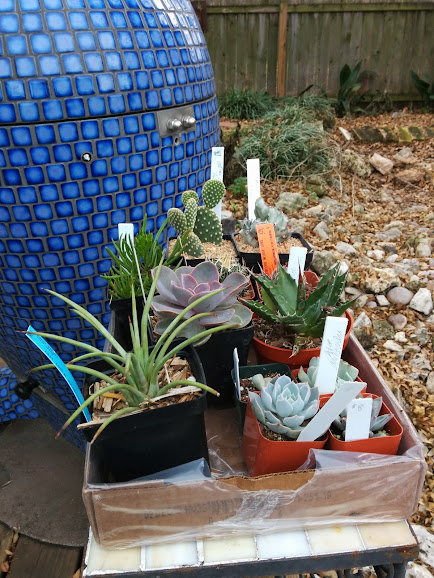Rather than do a gazillion posts (like I did for the front yard), I figure you all can handle just having one whole slew of photos of the back yard.
I'm starting to really like the back yard. I'm also starting to really want to get back to working on it. Unfortunately, I have a feeling that my yard is going to take a back seat to my parents yard this fall as they will have to have all their garden beds and plants designed and planted by the beginning of March. Which is both awesome and mind boggling. Po' Shawn. He's always complaining that I never spend enough time doing the yard work here at the house (more like I can find better things to do with my time than shear back plants or spread a few handfuls of compost), and this year there will likely be very little headway made on my
backyard plan because I will be helping my parents with theirs.
Above is a picture of the Iris Bed. you can see the original photos
here. It has obviously grown. The only downside is that only one of the irises bloomed this year - a Cemetery White. I also think the Jesse's Song iris died - or at least all of the leaves turned brown and disappeared. I'm not sure what, if anything, I'm doing wrong - maybe they're getting too much water, maybe they need to be fertilized, maybe they just don't get enough sunlight, or hell, maybe irises don't bloom that first year. I don't know. I should probably do some research into that... The artemisia (front) could stand to have a haircut. I have a feeling that the iris and the artemisia need much less water than they're getting in this spot - which means the problem is the petunia (back) because I'll water when they start looking sad - which is about once a week or so.

The "Mull-shay" bed, on the other hand, looks fantastic. Again - if we can just ignore the syrup barrel composter, the line of limestone blocks that I need to use and the fallen leaves, it would be pretty awesome. I'm not too happy with the Firespike (it's the tallish plant on the right in the front) as it requires more water than I like to give plants. I also, however, have a problem with removing plants...so I guess I need to hope for it to die off in some fashion. The Yarrow (the little plants in the front) are a bit of a disappointment, but maybe they just follow the adage, "first year they creep, second year they sleep, and third year they leap." I also have 4 Beauty Berry Bushes in little 6" pots by the Shrimp Plant (you can make out one pot in the far left of the photo). The Liriope (the strappy foliage) looks like it's trying to take over, and I do plan on removing a large clump of it since it's right in the middle of the pathway I take to the syrup composter. I will likely give this giant clump of liriope to my parents for their yard.

The "Grass Bed" was only ever half completed - as in I planted the grasses, but I never removed the St. Augustine. The plan was actually that the St. Augustine was supposed to have died out over this summer. Then we'd remove it and mulch the area and have a nice large mulched area for the clump grasses to go wild. The husband, however, decided that this was the year that he wasn't going to let the St. Augustine die off - mostly because this area is pretty decent, so his plan is to baby this area to get it good and healthy, then cut it up in strips and go place it in areas that the grass actually has died out. One of the Big Muhlies I planted died, so I think I'll put my little Caldwell Pink Rose in it's place - which means that there are 2 Big Muhlies and 2 Gulf Muhlies and 1 Pink Rose that's smack in the middle of them. I think it will probably look a little weird, but maybe I can fill in with some more Gulf Muhly or something.

The Photinia Bed went a bit crazy. It's mostly due to whatever plant it is that I seeded over there (cosmos maybe?). And as you can tell, that is the problem - I don't remember what seeds I threw out there, only that I threw them out there and they actually did start to grow. And grow. And grow. They're now 4 feet tall or so and show no signs of flowering. The area also has some Giant Mexican Petunia (mostly hidden by the other plants), and Milkweed in the front. I hope the Milkweed and Petunias return next year...and if I can only have one, I hope it's the milkweed.
Possumhaw bed - nothing much here other than I added an Autumn Sage (I got it for my parents and then ended up keeping it). And there are some self-seeded Wild Petunia.
The Rain Barrel Bed is starting to look pretty good - it has Brazos Penstemmon (in the back - and you can make out the seed heads which have fallen over), the Hamelia Patens "Nana" which is blooming, and then a "Blue Penstemmon" in the front, which also does not look like it plans to bloom anytime soon. I may end up moving the penstemmon to the possumhaw bed to give the Hamelia more room (especially considering that the Hamelia was the only thing on the plan in this area).

The Rock Bed is filling in nicely - I really should stay on top of the Henry Duelberg sage (in the rocks, on the left) - as in, I really need to cut back the long stems. I just never can do it because it always seems to have a small amount of blooms which the bees really appreciate. The funny thing, of course, is that I'm sure if I cut it back and watered it, it would bloom more prolifically. The Agave Lopantha is starting to pup (you can make out the mother plant in the rocks between, and behind, the sage and the rosemary which is front right). In pots, there's a Plumeria (the tree looking thing on the left), and a pot full of self-seeded Thai Basil. I should harvest it and make some more basil cubes.

Back on the other side of the yard, and next to the Mull-shay Bed, is the Turk's Cap Bed. The grasshoppers really did a number on all of my Turk's Cap this year - 4 plants and not a one looks good. The Turk's Cap is on the left (in case anyone didn't already know that), the Passion Vine (on the fence) has bloomed off and on all summer - would probably bloom more if I bothered to fertilize (aka Seaweeded or Fish Emulsioned) and water with some consistency. The Mexican Petunia (the tall plant right in front of the thermometer) likes this area a bunch - it's probably it's favorite location, but I'll eventually remove it all; once the Yaupon (which you can't even see) gets bigger. While I like the blooms of the White Philippine Violet (right), I don't like how much water it needs - between it and the Firespike mentioned above, I'm always watering one or the other with a bucket of water. I think I like this one just a tad more than the other, so I don't really want this one to die.

























































